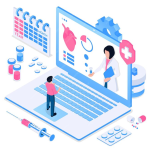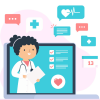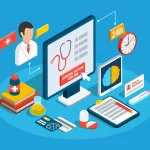
10 Ideas to Make Patient Feedback Systems More Accessible And User-Friendly
In today’s healthcare landscape, patient feedback mechanisms are crucial for improving service quality and patient satisfaction. These systems allow healthcare providers to gather insights directly from patients, ensuring a continuous loop of feedback and improvement.
However, to maximize their effectiveness, these systems must be accessible and user-friendly. This article explores ten innovative ideas to enhance patient feedback systems, making them more inclusive and easy to use for everyone.
Importance of a Patient Feedback System
A patient feedback system, whether referred to as a healthcare feedback system or a hospital feedback system, serves as a vital communication channel between patients and healthcare providers.
It helps identify areas of improvement, recognize patient needs and concerns, and enhance the overall quality of care.
An accessible and user-friendly system not only encourages more participation but also ensures that the feedback collected is representative and comprehensive.
1. User-Friendly Interface Design
The design of a patient feedback system or hospital feedback system is the first point of interaction for users. A clean, intuitive, and aesthetically pleasing interface can significantly enhance user experience.
The interface should include easy-to-navigate menus, clear call-to-action buttons, and concise prompts.
For instance, using large icons and straightforward language can make it easier for all users, including those with limited technical skills, to engage with the system.
2. Multilingual Support
To cater to a diverse patient population, offering multilingual support is essential. A patient feedback system, including those in regions like India where diverse languages are spoken, should provide options to submit feedback in multiple languages.
This ensures that language barriers do not hinder patient participation. This can be achieved by integrating translation features or providing language-specific versions of the feedback forms.
Multilingual support not only broadens accessibility but also makes patients feel valued and understood.
3. Mobile Compatibility
In an era where smartphones are ubiquitous, ensuring that the patient feedback system is mobile-friendly is a must. A responsive design that adapts seamlessly to various screen sizes enhances accessibility, allowing patients to provide feedback from their devices at any time.
This convenience can lead to higher participation rates, as patients can easily submit their patient experience feedback without needing access to a computer.
4. Accessibility for All Abilities
An inclusive patient feedback system must accommodate users with different abilities. This includes features like screen reader compatibility for visually impaired users, keyboard navigation for those who cannot use a mouse, and adjustable text sizes.
Additionally, ensuring compliance with accessibility standards such as the Web Content Accessibility Guidelines (WCAG) can help in creating a more inclusive platform.
5. Anonymity and Privacy Assurance
Patients are more likely to provide honest feedback if they are assured of their privacy. A patient feedback system should prioritize data security and offer options for anonymous submissions.
This reassurance can encourage more candid feedback, which is invaluable for identifying genuine areas for improvement. Clear communication about how the data will be used and protected also builds trust and encourages participation.
6. Real-Time Feedback Mechanisms
Integrating real-time feedback mechanisms can significantly enhance the effectiveness of a patient feedback system. Features like live chat support, instant surveys, or in-app feedback options allow patients to provide immediate responses.
This not only captures the patient experience feedback while it is fresh but also enables healthcare providers to address concerns promptly. Real-time feedback can also be particularly useful in monitoring ongoing treatments and services.
7. Simple and Clear Instructions
Clarity is key in ensuring that patients can easily navigate the patient feedback system. Providing simple and concise instructions at each step helps reduce confusion and make the process more user-friendly.
The use of bullet points, short sentences, and clear headings can guide users through the feedback process effortlessly. Additionally, offering a help or FAQ section can assist users who may have questions or encounter difficulties.
8. Incorporating Visual and Audio Aids
To enhance understanding and engagement, incorporating visual and audio aids in the patient feedback system can be highly beneficial. Visual aids such as icons, images, and diagrams can help illustrate points and guide users through the process.
Audio aids, including voice instructions or the option to submit feedback via voice recordings, can cater to those who prefer auditory communication. These aids can make the system more accessible to users with different preferences and needs.
9. Feedback Collection at Multiple Touchpoints
A comprehensive patient feedback system should collect feedback at various touchpoints throughout the patient journey. This includes pre-appointment surveys, in-visit feedback forms, and post-treatment evaluations.
By gathering feedback at multiple stages, healthcare providers can gain a more nuanced understanding of the patient experience. It also ensures that feedback is collected continuously, providing a constant stream of data for quality improvement.
10. Personalized Follow-Up Communications
Following up with patients after they provide feedback shows that their input is valued and taken seriously. Personalized follow-up communications, such as thank-you messages or updates on how their feedback is being used, can enhance patient engagement.
It also fosters a sense of connection and trust between patients and healthcare providers. A patient feedback system that includes automated follow-up options can streamline this process, ensuring timely and consistent communication.
Benefits of an Accessible Patient Feedback System
Implementing an accessible and user-friendly patient feedback system offers numerous benefits. It increases participation rates, as more patients are willing and able to provide feedback.
This leads to a more comprehensive understanding of patient experiences. Helping healthcare providers to identify and address issues more effectively.
Moreover, an accessible system promotes inclusivity, ensuring that feedback represents the diverse voices of all patients. It also enhances patient satisfaction and trust, as patients feel heard and appreciated.
Challenges in Implementing User-Friendly Feedback Systems
Despite the advantages, there are challenges in implementing a user-friendly patient feedback system. One major challenge is the need for continuous updates and maintenance to keep the system running smoothly and securely.
Additionally, ensuring that the system remains user-friendly while incorporating complex features like multilingual support and real-time feedback can be challenging.
Another issue is balancing the need for comprehensive data collection with user convenience, as overly complex forms can deter participation.
Future Trends in Patient Feedback Systems
Looking ahead, several trends are likely to shape the future of patient feedback systems. The use of artificial intelligence and machine learning for analyzing feedback data is expected to become more prevalent.
These technologies can provide deeper insights and identify patterns that may not be immediately obvious. Additionally, the integration of wearable technology and mobile apps for continuous feedback collection is likely to grow.
This can provide real-time data on patient experiences, allowing for more proactive healthcare management.
Conclusion
Creating an accessible and user-friendly patient feedback system is essential for healthcare providers seeking to improve patient satisfaction and quality of care.
By incorporating features such as user-friendly interface design, and multilingual support. Mobile compatibility, and real-time feedback mechanisms, healthcare providers can create a system that is inclusive and easy to use.
Overcoming the challenges in implementation and staying abreast of future trends will ensure that these systems continue to evolve and meet the needs of all patients.
Frequently Asked Questions
What Are The Key Features of A User-Friendly Patient Feedback System?
Key features include a clean and intuitive interface, multilingual support, mobile compatibility, and accessibility options for users with different abilities.
How Can Patient Feedback Systems Ensure Data Privacy?
Systems can ensure privacy by offering anonymous submission options and implementing robust data security measures.
Why is Multilingual Support Important in Patient Feedback Systems?
Multilingual support is crucial as it allows patients from diverse linguistic backgrounds to provide feedback comfortably.
How Can Real-Time Feedback Mechanisms Improve Patient Feedback Systems?
Real-time feedback mechanisms capture immediate patient responses, allowing for quick identification and resolution of issues.
What Are The Benefits of Collecting Feedback at Multiple Touchpoints?
Collecting feedback at multiple touchpoints provides a comprehensive view of the patient journey, helping to identify specific areas for improvement.
How do Personalized Follow-Up Communications Impact Patient Satisfaction?
Personalized follow-up communications show that patient feedback is valued, enhancing patient trust and engagement with the healthcare provider.
Enhance Patient Care and NABH Compliance with LazyMonkey
LazyMonkey is your all-in-one solution for improving patient care, retaining more patients, and meeting NABH standards. Our powerful QR-based feedback tool enables you to capture real-time insights from patient feedback, discharge surveys, staff and doctor evaluations, and clinical research, while also streamlining inter-departmental communication.
Transform your healthcare facility today - reach out to us at [email protected], or request a demo here!
Elevate Your Restaurant Experience with LazyMonkey
LazyMonkey’s QR-based feedback system helps you gather real-time insights from customers, track satisfaction levels, and enhance the dining experience. Get instant feedback on your menu, service, and ambience, and make data-driven improvements to boost repeat customers and reviews.
Improve your restaurant today – reach out to us at [email protected], or request a demo here!
Empower Student Engagement and Campus Improvement with LazyMonkey
LazyMonkey offers a seamless way to gather student feedback, track satisfaction, and enhance campus life. From course evaluations to dorm feedback, our QR-based solution makes it easy to capture valuable insights and improve student retention.
Upgrade your university experience – contact us at [email protected], or request a demo here!
Streamline Feedback and Drive Performance Across Your Enterprise/Franchise with LazyMonkey
Whether you manage one or multiple locations, LazyMonkey’s QR-based feedback system helps you gather real-time employee and customer feedback. Improve operational efficiency, track satisfaction, and make data-driven decisions to enhance brand consistency and growth.
Transform your franchise today – reach out to us at [email protected], or request a demo here!
Enhance Customer Satisfaction and Service Standards in Banking with LazyMonkey
LazyMonkey empowers banks to capture real-time feedback from clients across branches. Improve customer experience, assess service quality, and ensure regulatory compliance with our QR-based solution, helping you retain clients and meet banking standards.
Elevate your bank’s customer care – contact us at [email protected], or request a demo here!
Boost Customer Engagement and Mall Satisfaction with LazyMonkey
LazyMonkey’s QR-based feedback tool enables you to collect feedback from shoppers, track satisfaction, and enhance the mall experience. Gather insights on store services, cleanliness, and entertainment to create an unmatched customer journey.














